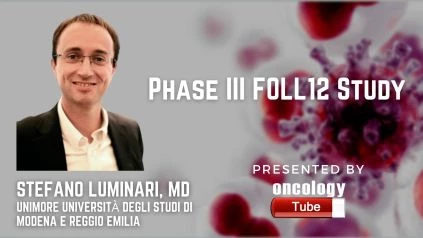Stefano Luminari, MD, Department of Surgery, Medicine, Dentistry and Morphological Sciences with interest in Transplantation, Oncology and Regenerative Medicine at Unimore Università degli studi di Modena e Reggio Emilia (UNIMORE). In this video, he speaks about FOLL12: Response-Adapted Maintenance Not Supported in Follicular Lymphoma.
Â
Intent
Â
In patients with follicular lymphoma who had responded to induction immunochemotherapy, we compared 2 years of rituximab maintenance (RM) with a response-adapted postinduction strategy.
Â
Approaches
On the basis of metabolic response and molecular assessment of minimal residual illness, we randomly assigned treatment-naive, advanced-stage, high-tumor burden follicular lymphoma patients to either standard RM or a response-adapted postinduction strategy (MRD). The experimental arm used three types of postinduction therapies: observation for complete metabolic response (CMR) and MRD-negative patients; four doses of rituximab (one per week, maximum three courses) until MRD-negative for CMR and MRD-positive (end of induction or follow-up) patients; and one dose of ibritumomab tiuxetan followed by standard RM for non-CMR patients. The study was intended to be a noninferiority trial with progression-free survival (PFS) as the major endpoint.
Outcomes
A total of 807 patients were randomized at random. Patients in the normal arm had a considerably superior PFS than those in the experimental arm after a median follow-up of 53 months (range, 1-92 months) (3-year PFS 86 percent v 72 percent; P.001). Except for non-CMR patients (n = 65; P =.274), the conventional arm had a greater PFS than the experimental arm in all study categories. In the reference and experimental arms, 3-year overall survival was 98 percent (95 percent CI, 96 to 99) and 97 percent (95 percent CI, 95 to 99), respectively (P =.238).
Inference
In the FOLL12 research, metabolic and molecular response-adapted treatment was linked with significantly worse PFS compared to 2-year RM. The superior efficacy of standard RM was verified in the subgroup analysis, especially for patients who achieved both CMR and MRD-negative status.

